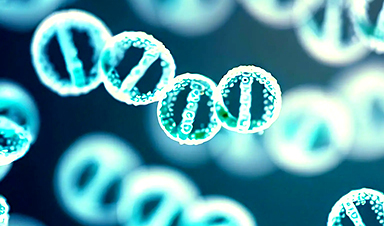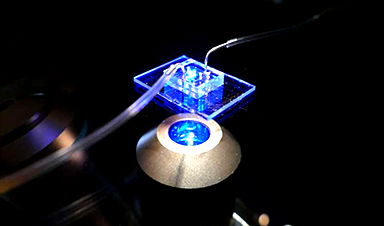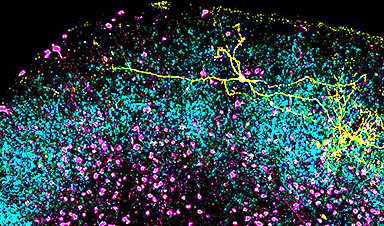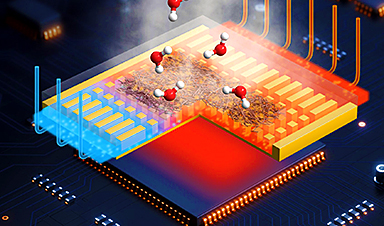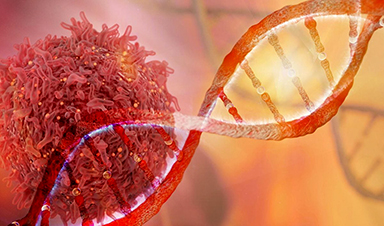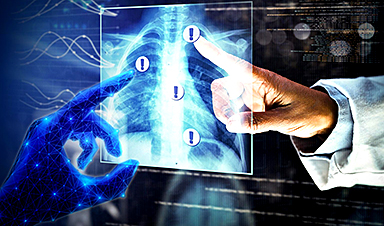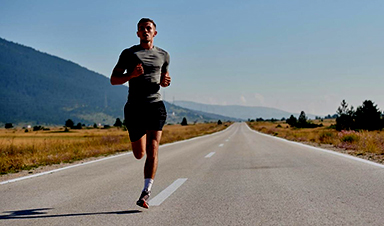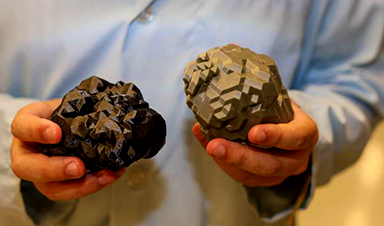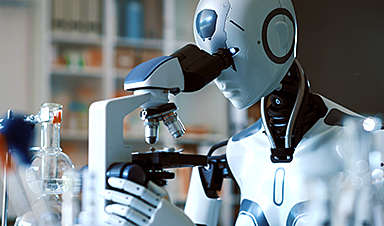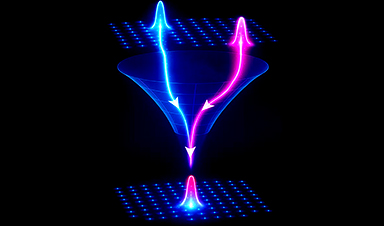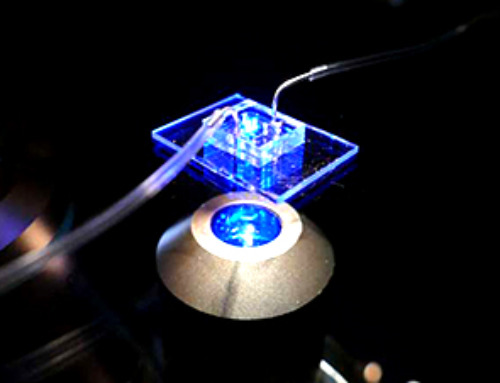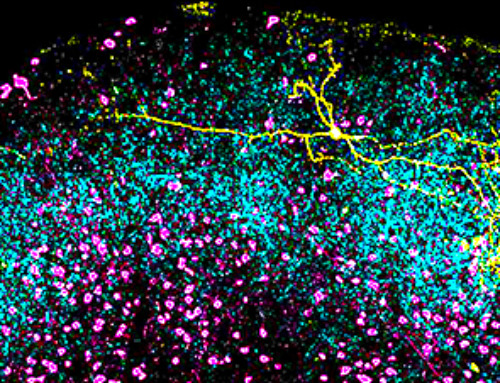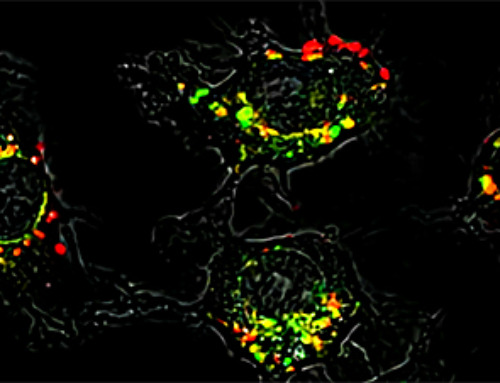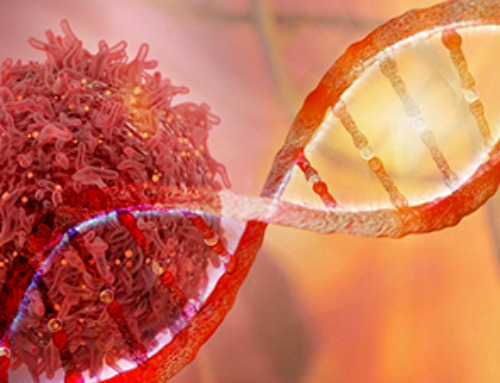Tiny circles of DNA harbor cancer-associated oncogenes and immunomodulatory genes promoting cancer development. They arise during the transformation from pre-cancer to cancer, say Stanford Medicine-led team.
Tiny circles of DNA that defy the accepted laws of genetics are key drivers of cancer formation, according to an international study led by researchers at Stanford Medicine.
The circles, known as extrachromosomal DNA or ecDNA, often harbor cancer-associated genes called oncogenes. Because they can exist in large numbers in a cell, they deliver a super-charged growth signal that can override a cell's natural programming. They also contain genes likely to dampen the immune system's response to a nascent cancer, the researchers found.
"This study has profound implications for our understanding of ecDNA in tumor development," said professor of pathology Paul Mischel, MD. "It shows the power and diversity of ecDNA as a fundamental process in cancer. It has implications for early diagnosis of precancers that put patients at risk, and it highlights the potential for earlier intervention as treatments are developed."
Mischel is one of six senior authors of the research, which was published recently in the journal Nature. Howard Chang, MD, PhD, professor of genetics and the Virginia and D.K. Ludwig Professor in Cancer Research, is also a senior author. Other senior authors include senior staff scientist Thomas Paulson, PhD, from Seattle's Fred Hutchison Cancer Center; assistant professor of pediatrics Sihan Wu, PhD, assistant professor at Children's Medical Center Research Institute at the University of Texas Southwestern Medical Center; professor of computer science and engineering Vineet Bafna, PhD, from UC San Diego; and professor of cancer prevention and director of the Early Cancer Institute Rebecca Fitzgerald, MD, from the University of Cambridge.
"People with ecDNA in their precancerous cells are 20 to 30 times more likely than others to develop cancer," Chang said. "This is a huge increase, and it means we really need to pay attention to this. Because we also found that some ecDNAs carry genes that affect the immune system, it suggests that they may also promote early immune escape."
A grand challenge
Deciphering ecDNA's role in cancer was one of four Cancer Grand Challenges awarded by the National Cancer Institute and Cancer Research UK in 2022. The grand challenges program was launched to bring together researchers from around the world to tackle complex research topics too daunting for any one group. Mischel was awarded $25 million to lead a team of international researchers to learn more about the circles. But first they had to jettison some key genetic principles that have guided the field for nearly 200 years.
"When we think about how a tumor evolves in a patient and in response to treatment, we think of the branching trees of life proposed by Charles Darwin," Mischel said. "This idea is so powerful that researchers often sequence the DNA from multiple parts of a tumor and draw these trees to learn about its evolution. If a mutation is there at the trunk of the tree and in all of its branches, we assume it is a key driver event in the formation of the tumor; if it is in only some branches, we assume it happened later in tumor development and may not be a good target for drug development."
But these assumptions hinge on the idea that all of a tumor's DNA is neatly contained on chromosomes, which are evenly divided among daughter cells each time a cancer cell divides — ensuring that each new cell gets one, and only one, copy of each chromosome.
In contrast, the tiny ecDNA circles swirl in a dividing cell like bubbles circling a bathtub drain and are portioned willy-nilly between the new daughter cells. One may get nearly all the circles; the other, almost none. As the generations accumulate, the evolutionary tree favored by Darwin begins to look decidedly odd, with the appearance of ecDNA-bearing cells sprinkled among the branches like haphazardly hung Christmas lights.
"Some researchers have looked at the evolutionary trees and decided that, because you see it here, but not there, it must be that ecDNA formation is a late event and probably isn't important when considering treatments," Mischel said. "Our team thought that interpretation was wrong."
Pinpointing a reason
To get to the bottom of the tiny circles, Mischel, Chang and their collaborators turned to a specific example of cancer development — people with a condition known as Barrett's esophagus, which occurs when the cells lining the lower part of the esophagus are damaged by acid reflux and become more like cells lining the intestine than healthy esophageal tissue. About 1% of these people develop esophageal cancer, which is difficult to treat and has a high mortality rate. Because the outcome is so poor, people with Barrett's esophagus are routinely monitored with endoscopies and biopsies of the abnormal tissue. Because of these frequent biopsies, the researchers had access to tissue samples collected both before and after cancers developed.
The researchers assessed the prevalence of ecDNA, and identified the genes they carried, in biopsies from nearly 300 people with Barrett's esophagus or esophageal cancer treated at the University of Cambridge or at Seattle's Fred Hutchison Cancer Center, where individual patients were studied as the cancer developed. They found that the prevalence of ecDNA increased from 24% to 43% in early- versus late-stage esophageal cancer, indicating the continual formation of the DNA circles during cancer progression. More tellingly, they found that 33% of people with Barrett's esophagus who developed esophageal cancer had ecDNA in their precancerous cells. In contrast, only one out of 40 people who didn't develop cancer had cells with ecDNA, and that individual passed away due to another cause.
"The conclusions were remarkable," Mischel said. "We see that ecDNA can arise in these precancerous cells, and that if it is there, the patient is going to get cancer. We also saw the continuous formation of ecDNA as the cancer progresses, indicating that it is advantageous to cancer growth. Finally, we saw that the ecDNA can contain immune-modulatory genes in addition to oncogenes."
"If a gene is carried on ecDNA, it is very likely to be important for cancer," Chang said. "These circles are not only giving us new targets for cancer diagnosis and drug development; they are also teaching us what is important for tumor growth."
What to look at next
The researchers are planning to explore more about how ecDNAs arise in cancer cells and how they work together to make proteins that drive cancer cell growth. They saw that cancers with ecDNA were likely to also have mutations in a protein called p53. Sometimes called "the guardian of the genome," p53 temporarily halts the cell cycle to allow cells to repair damage or mutations to their DNA before beginning to divide.
"We want to learn more about the landscape of ecDNA in precancers and the risks it confers," Mischel said. "We also want to know if we can stop its formation or activity; how to improve our ability to detect their presence; how they affect the immune system; and whether there are opportunities for new, novel therapies. There is much more to learn, and our team is excited to tackle all these issues. But what we do know for certain is that these tiny DNA circles are a very big deal in cancer."
News
Lipid nanoparticles discovered that can deliver mRNA directly into heart muscle cells
Cardiovascular disease continues to be the leading cause of death worldwide. But advances in heart-failure therapeutics have stalled, largely due to the difficulty of delivering treatments at the cellular level. Now, a UC Berkeley-led [...]
The basic mechanisms of visual attention emerged over 500 million years ago, study suggests
The brain does not need its sophisticated cortex to interpret the visual world. A new study published in PLOS Biology demonstrates that a much older structure, the superior colliculus, contains the necessary circuitry to perform the [...]
AI Is Overheating. This New Technology Could Be the Fix
Engineers have developed a passive evaporative cooling membrane that dramatically improves heat removal for electronics and data centers Engineers at the University of California San Diego have created an innovative cooling system designed to greatly enhance [...]
New nanomedicine wipes out leukemia in animal study
In a promising advance for cancer treatment, Northwestern University scientists have re-engineered the molecular structure of a common chemotherapy drug, making it dramatically more soluble and effective and less toxic. In the new study, [...]
Mystery Solved: Scientists Find Cause for Unexplained, Deadly Diseases
A study reveals that a protein called RPA is essential for maintaining chromosome stability by stimulating telomerase. New findings from the University of Wisconsin-Madison suggest that problems with a key protein that helps preserve chromosome stability [...]
Nanotech Blocks Infection and Speed Up Chronic Wound Recovery
A new nanotech-based formulation using quercetin and omega-3 fatty acids shows promise in halting bacterial biofilms and boosting skin cell repair. Scientists have developed a nanotechnology-based treatment to fight bacterial biofilms in wound infections. The [...]
Researchers propose five key questions for effective adoption of AI in clinical practice
While Artificial Intelligence (AI) can be a powerful tool that physicians can use to help diagnose their patients and has great potential to improve accuracy, efficiency and patient safety, it has its drawbacks. It [...]
Advancements and clinical translation of intelligent nanodrugs for breast cancer treatment
A comprehensive review in "Biofunct. Mater." meticulously details the most recent advancements and clinical translation of intelligent nanodrugs for breast cancer treatment. This paper presents an exhaustive overview of subtype-specific nanostrategies, the clinical benefits [...]
It’s Not “All in Your Head”: Scientists Develop Revolutionary Blood Test for Chronic Fatigue Syndrome
A 96% accurate blood test for ME/CFS could transform diagnosis and pave the way for future long COVID detection. Researchers from the University of East Anglia and Oxford Biodynamics have created a highly accurate [...]
How Far Can the Body Go? Scientists Find the Ultimate Limit of Human Endurance
Even the most elite endurance athletes can’t outrun biology. A new study finds that humans hit a metabolic ceiling at about 2.5 times their resting energy burn. When ultra-runners take on races that last [...]
World’s Rivers “Overdosing” on Human Antibiotics, Study Finds
Researchers estimate that approximately 8,500 tons of antibiotics enter river systems each year after passing through the human body and wastewater treatment processes. Rivers spanning millions of kilometers across the globe are contaminated with [...]
Yale Scientists Solve a Century-Old Brain Wave Mystery
Yale scientists traced gamma brain waves to thalamus-cortex interactions. The discovery could reveal how brain rhythms shape perception and disease. For more than a century, scientists have observed rhythmic waves of synchronized neuronal activity [...]
Can introducing peanuts early prevent allergies? Real-world data confirms it helps
New evidence from a large U.S. primary care network shows that early peanut introduction, endorsed in 2015 and 2017 guidelines, was followed by a marked decline in clinician-diagnosed peanut and overall food allergies among [...]
Nanoparticle blueprints reveal path to smarter medicines
Lipid nanoparticles (LNPs) are the delivery vehicles of modern medicine, carrying cancer drugs, gene therapies and vaccines into cells. Until recently, many scientists assumed that all LNPs followed more or less the same blueprint, [...]
How nanomedicine and AI are teaming up to tackle neurodegenerative diseases
When I first realized the scale of the challenge posed by neurodegenerative diseases, such as Alzheimer's, Parkinson's disease and amyotrophic lateral sclerosis (ALS), I felt simultaneously humbled and motivated. These disorders are not caused [...]
Self-Organizing Light Could Transform Computing and Communications
USC engineers have demonstrated a new kind of optical device that lets light organize its own route using the principles of thermodynamics. Instead of relying on switches or digital control, the light finds its own [...]
